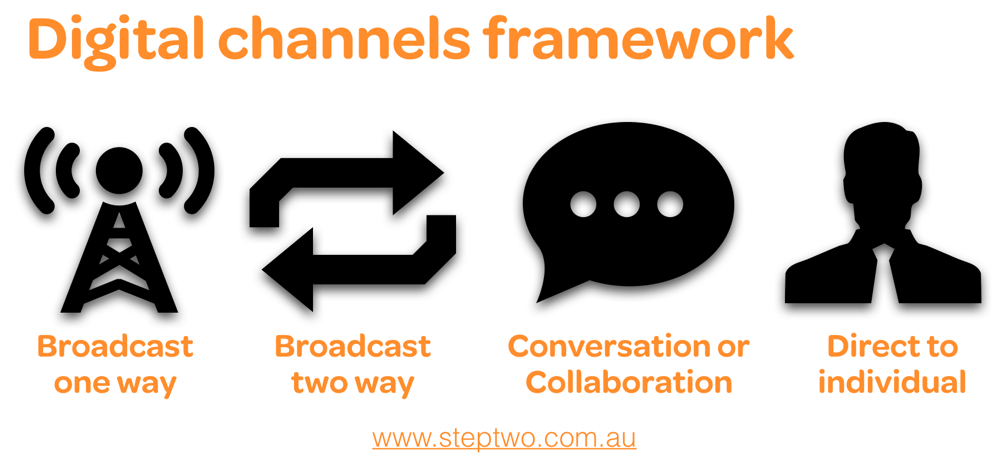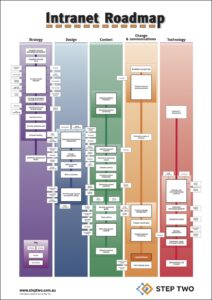
Filed under: Intranets, Latest Features
The way the world communicates is going through an enormous (and sometimes painful) transformation.
Newspapers and other printed media are going out of business. YouTube is the preferred source of media for many in younger generations, and YouTube stars are making millions. Twitter is now used to communicate government decisions, ahead of formal media briefings.
Ready or not, changes are coming to internal communications. The good news is that there are new and often more engaging digital channels on offer. The challenge is having a clear internal communications strategy that ensures that staff and business needs are met.
This article outlines a simple, yet powerful, digital channels framework that can be used by internal communicators.
The fundamentals remain
The starting point for any internal communications strategy is a set of fundamental guiding principles.
However news is communicated, messages must be:
- Authentic, reflecting both the culture of the business and the personality of the person writing the message.
- Relevant, with a clear connection to the activities, needs and interests of staff.
- Timely, with early communication of major changes, and just-in-time delivery of other messages.
These principles remain every bit as important, even as new digital channels are introduced into organisations.
A digital channels framework for internal communicators
Every organisation should have a clear internal communications strategy that outlines which channels to use, for what and when.
In the past, this was relatively simple: email was the primary channel, supported by the intranet and perhaps printed newsletters.
The explosive growth of new digital channels has muddied things, even as it provides new opportunities for internal communicators.
To help with planning, it’s useful to draw on an overall digital channels framework, that encompasses four major categories:
- Broadcast one way, sending out mass messages to the whole organisation.
- Broadcast two way, engaging the organisation as a whole around key messages.
- Conversation or collaboration, drawing on the social capabilities of new tools.
- Direct to individual, cutting through the complexity of organisations to deliver targeted messages.
This article will explore and provide examples for each of these channels.

Channel 1: Broadcast one way
This is the original and still most-used internal communications channel.
In many organisations, all staff emails are still widely used, and they have the advantage of both simplicity and reach. The corporate intranet is then the most visible delivery mechanism for broadcast messages.

Intranets can provide a rich and well-structured channel for broadcast communication. Screenshot courtesy of MMG.
Broadcast communications can be enriched by video, often portraying senior leaders, but sometimes used more comprehensively.
The Green Room at HEINEKEN is an award-winning example that blends both internal and external communication.
This example from PayPal is also particularly delightful:
News can be delivered to mobile devices, which ensures that messages are timely. It can also support a broader readership that includes field and frontline staff who may not have access to desktop PCs. (And perhaps: should mobile be considered the primary channel for internal comms?)

Broadcast internal communications should be delivered to mobile devices in a rich way. Screenshot courtesy of Commonwealth Bank.
Broadcast communication is rounded out with the use of digital signage placed in highly trafficked areas of offices and field locations.

Digital signage should be included in an internal communications strategy. Image courtesy of Jemena.
Channel 2: Broadcast two way
Messages can be pushed out to the entire organisation, while giving staff an opportunity for their voice to be heard. Communication teams can encourage this behaviour, with the objective of strengthening staff engagement.
The simplest way to achieve this is via commenting on news, which provides a way of ‘easing into’ more extensive interaction.

Commenting on news is a great way of strengthening a sense of community. Screenshot courtesy of YMCA.
Likes and star ratings can also help internal communications teams to understand which messages are the most valuable and interesting for staff.

This intranet has multiple forms of two-way communication, including star ratings and comments. Screenshot courtesy of IMF.
Channel 3: Conversation or collaboration
Collaboration and social tools are about enabling peer-to-peer communication and knowledge sharing. The conversational style of interaction is very effective at deepening staff engagement and increasing business productivity.

Social tools support peer-to-peer discussions in a very authentic way. Screenshot courtesy of Wendy’s.
Internal communicators clearly can’t ‘control’ collaboration spaces, and nor should they try. They can play a valuable community manager role, facilitating conversations and encouraging adoption. Active engagement in these spaces also lays the groundwork for folding collaboration into the larger internal communications strategy.

Social and collaboration tools can be used to distribute corporate news. Screenshot courtesy of Virgin Trains.
Channel 4: Direct to individual
The final digital channels leaves nothing to chance. Using a range of technologies, messages can be pushed directly to staff, straight into their working environment.
This could involve a number of approaches, including:
- desktop notifications in Windows
- popup messages on the intranet
- push notifications to mobile devices
- apps specifically designed to enable directed messaging
This channel is largely dominated by product offerings that sit alongside existing channels, such as the intranet and collaboration tools. While powerful, it needs to be used sparingly, lest users rebel against constant ‘interruptions’.
Plan your pathway to success
There are four channels to consider when planning internal communications strategies:
- broadcast one way
- broadcast two way
- conversation or collaboration
- direct to individual
A mix of these channels will be needed in most organisations, with a clear model for what is used when. The changing face of technology must be factored in, and the role of the internal comms team decided.
There’s a new world of digital opportunities, so make the most of them!





